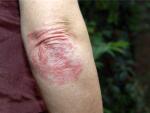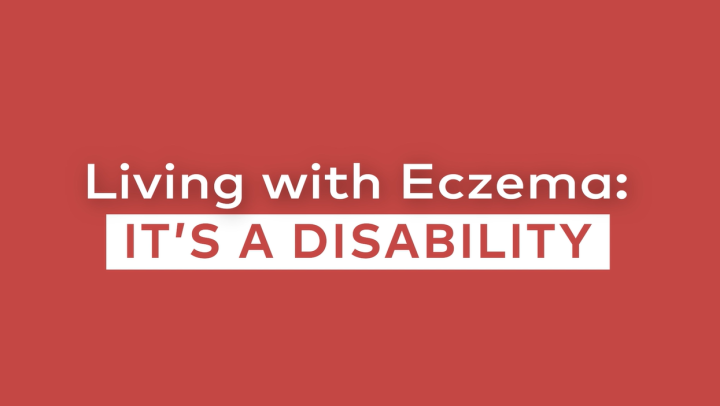An elbow rash may occur from a condition such as atopic dermatitis. This type of eczema affects about 16.5 million adults in the United States, according to the National Eczema Association. Alternatively, you may develop a rash after coming into contact with an irritant or allergen. This is irritant contact dermatitis.
Read on to learn more about what causes an elbow rash, as well as how to treat it.

What does a rash on the elbow look like?
An elbow rash can have different appearances. It may look:
- bumpy
- flaky
- scaly
- swollen
- pus filled
Depending on your skin color, an elbow rash may appear:
- red
- purple
- ashen
- brown
- gray
What causes an elbow rash?
Allergens, infections, autoimmune disorders, or stress may cause an elbow rash.
Contact dermatitis
Contact dermatitis is a rash from something that irritates your skin or something you are allergic to.
Irritant contact dermatitis
Irritant contact dermatitis accounts for about 80% of all contact dermatitis, according to the National Eczema Association. Common irritants include:
- antibacterial products
- soaps and detergents
- solvents
- machine oil
- cement
- powders and dust
- plants
- water, including hard water and chlorinated water
You may find that irritant contact dermatitis worsens in the heat or the cold, or in dry environments.
Allergic contact dermatitis
Allergic contact dermatitis typically appears 48–72 hours after exposure to the allergen. Common allergens include:
- perfumes
- rosin in plasters or Band-Aids
- topical medications
- plants, such as poison ivy
- nickel
Allergic reactions to certain foods, medications, or insect bites can result in rash. These rashes are likely to spread to other parts of your body.
Learn more about contact dermatitis.
Infections and health conditions
An infection or health condition can cause an elbow rash.
Infections that can cause rash include:
- chickenpox or shingles
- impetigo
- Lyme disease
- ringworm
- measles, mumps, and rubella
- Rocky Mountain spotted fever
- meningitis
Other conditions that may cause rash include:
- eczema
- psoriasis
- rheumatoid arthritis
- dermatitis herpetiformis, also known as gluten rash
- granuloma annulare
- dermatomyositis
- pityriasis rosea
- erythema nodosum
- scabies
- Kawasaki disease
Other causes
Other possible causes of a rash on the elbow include:
- exposure to hot or cold temperatures
- sunburn
- stress
Contact your doctor if you have a persistent or painful rash, particularly if you do not know what caused it.
How do I treat an elbow rash?
Treatment for a rash on the elbow can include home remedies and medications.
Home remedies for an elbow rash
Home remedies for treating a rash include:
- spending time in cool, airy spaces
- wearing loose sleeves to stay cool and dry
- taking frequent cool baths or showers, especially for heat rash
- applying a cool compress to soothe an itchy rash
- soaking in an oatmeal bath
Avoid known allergens or irritants as much as possible. For example, wear long gloves when washing dishes to prevent dripping water from reaching your elbows. Wear long sleeves if you work in an environment where you cannot avoid the irritant.
Medical treatments for an elbow rash
Over-the-counter and prescription medications can help relieve rash. Your doctor or pharmacist will recommend medications such as:
- topical corticosteroids
- steroid tablets, if contact dermatitis affects large areas of your body
- immunosuppressant therapy to reduce inflammation
- antihistamines to alleviate itchiness
Your doctor or dermatologist may also recommend phototherapy. This therapy uses ultraviolet light to improve the appearance of the skin. Another option may be cryotherapy, freezing small patches of bumps on the skin.
When should I contact a doctor?
Contact your doctor if you have a rash that does not go away with home remedies or over-the-counter medications.
You should also contact your doctor if you experience the following symptoms or signs of infection:
- fever
- blistering
- pus coming from the site of the rash
- spread of the rash
Signs of infection include:
- crusting
- green or yellow fluid
- swelling
- streaking
- warmth
How do doctors diagnose the cause of an elbow rash?
Your doctor will evaluate the rash and may perform tests, including:
- a patch test
- a blood test
- a skin biopsy
For a patch test, your doctor will place small patches on your skin. You will wear the patches for 48–96 hours, or 2–4 days, and then return to your doctor. They will see if you have reacted to any of the patches. A rash that appears at the site of the patch test indicates an allergy or irritation.
Learn more about allergy skin testing.
A blood test can show if you have an allergy or a viral, fungal, or bacterial infection.
During a skin biopsy, your doctor will remove a small piece of skin for laboratory analysis. The results may indicate skin conditions such as psoriasis or eczema, or an infection.
Can I prevent an elbow rash?
If an underlying medical condition is causing a rash, follow the treatment plan your doctor provides to reduce your symptoms.
If you are unable to avoid an allergen or irritant that causes a rash, wear loose-fitting long sleeves to protect your elbows.
Other frequently asked questions
Here are questions people also ask about rash on the elbows.
Can you get eczema on your elbows?
Eczema can appear anywhere on your body, including your elbows. However, eczema most frequently occurs in creases of the skin, such as the crooks of the arms.
What does psoriasis on the elbows look like?
Psoriasis affecting the elbows typically is plaque psoriasis. This appears as patches of thick raised skin that looks silvery and scaly.
What is gluten rash on elbows?
Gluten rash, or dermatitis herpetiformis, is a condition associated with celiac disease. Eating gluten causes itchy and blistering rashes to appear on the elbows, knees, and buttocks. You usually will experience symptoms on both elbows. The rash can often go away spontaneously.
Summary
An elbow rash can occur when you come into contact with an allergen or irritant, or as a result of an underlying condition.
Treatments for an elbow rash include over-the-counter and prescription medications, a cool compress or water, and avoidance of allergens and irritants.
Contact your doctor if you have a new or persistent rash, particularly if it does not respond to over-the-counter medications or home treatments.




















